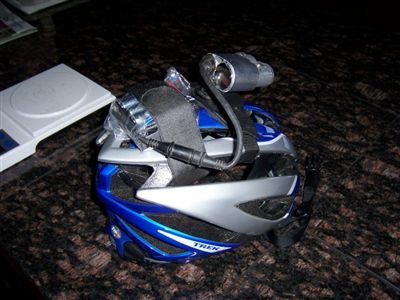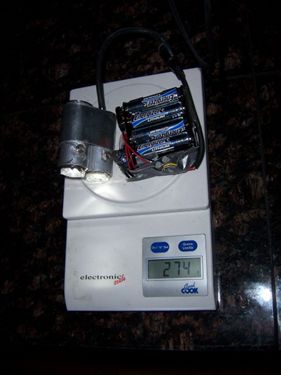For the past 10 years, heavy batteries & light systems is something I've just accepted as part of night riding. Then last year I raced the Steamboat 24 hour race - and that changed my thinking entirely. The course is one big climb followed by one big descent. 2100' from 6,900' to 9,000', so when night came and I strapped on my Niterider HID helmet and Niterider Classic bar system, I just added about 1850 grams, or 4.6 lbs! Sweet, I busted my a$$ to get down below 145 lbs for this event, then put 5 right back on in an instant.
The research began. What lights produce adequate runtimes, are lightweight, and have good light qualities? HID is great, no doubt about it. The new Flight and Moab models from Niterider look relatively lightweight, too. Those might be good options, but spendy. This sport is killing me...keep looking. What about LED technology? Last year I test drove some SolidLights, and although the light seemed good, the batteries died after 20 minutes. Glad I brought one of my own systems as backup! To their credit, they were probably just not sufficiently charged. But, those batteries were tiny and very light. I was intrigued.
I looked into more LED stuff. At Old Pueblo, Dinotte was supposed to have lights on hand and a vendor setup - I looked and looked, they were nowhere to be found. Persistant as I am, I shot off emails to them, which were not returned. 2 strikes you're out. Almost had a doulbeshot purchased, but the vendor wouldn't ship to any address other than the billing address, WTF? OK, whatever...the doubleshot heavy anyway at 650 grams since they use yesterday's battery technology for today's lighting.
As the saying goes, necessity is the mother of all invention. Diving deep into the research, there's a fellow in the UK that I know as "robdeanhove" who appears to be the guru of do it yourself LED systems. He apparently pioneered such efforts, and it makes sense this would come out of the UK. They have a lot of darkness in winter. Regionally, Chris has also gotten into the DIY LED fray. He provided some vendor links I found invaluable.
So let's cut to the chase. The last LED post showed a single 5W LED helmet mount. The LuxeonV stars have an anomoly that creates a dark spot in the center of the beam pattern for all but a 10 degree lens. After testing this light, it clearly is more along the lines of a flood light - which for me means it is going on the bars. So I decided to make a 2 x 3W head torch, which I believe is what the doubleshot is. I used aluminum pipe stock for the housing. The LEDs are heat sinked by cutting strips of aluminum sheeting, folding them so they follow the inside of the tube, and are bolted to the tube. This provides a solid base for the LED. The lens holder is epoxied to the LED, and that assembly is epoxied to the tube, seated against the heat sink, with some Radio Shack heat sink compound in between the two for good measure. Both lenses are 5 degree spot beams, but are easily changes to suit preference. I had a final requirement that the whole shebang mounts to the helmet. I hate wires coming down my back...here'tis:

Lightweight, too.

That's right - less that half the weight of the doubleshot. Runtime with this setup is a little over 4 hours compared to the 5 of the doubleshot. However, I can dim the lights to conserve when I don't need full power - the doubleshot is simply on or off. Ease the power back on climbs and it will go for 6 hours.
Why is this so much lighter than the commercial product? Mostly the battery technology. After looking at all the battery combinations at www.batteryspace.com, nothing - not even the polymer LiOn batteries - comes close to the mAh to weight ratio of the new Energizer lithium batteries. The closest the custom solutions came was about 61% of the Energizer AAs. Of course there's pro's and cons to using the Energizers. They can be found anywhere, which makes this a really good solution for events like the Great Divide Race or the Grand Loop Race (the latter of which I'm seriously considering...but that's ANOTHER story...). Also, they don't have to be the fancy Lithium AAs, the light will work off any AA battery, the difference of course is in the runtime. I've got some NiMH rechargables that instead of 4+ hours will go for about 2:45, and for 8 of them weigh in at 120 grams more. The downside would be replacing expendible batteries, and the energizer lithiums are expensive. For special events where space and weight are important, it's an expense I'll swallow. The lighting electronics are quite flexible as well. The head torch can use any niterider battery, and the bar torch can use any 13.2 volt niterider battery. So all those heavy archaic batteries will still get some use ;)
But the proof is in the pudding, right? I gave them a test run this am, going up the Colorado trail at 4:30 am. They are freaking bright! The helmet spot beams especially are bright, so much so that if they are pointed too low they completely wash everything out. LED light is very white. The 5W 10 degree on the bars is perfect for those long initial climbs at KTR, and the spot beams have a very long reach to help the high speed descent off of Beaver Mesa.
It's a bit early to claim total success on the project, but so far so good. The weight savings over my traditional setup? 1290 grams, or about 51 ounces, or about 3.2 pounds. Plus a lot more runtime: 5+ hours on the bar light, compared to 3 with a single beam on the previous setup.
KTR will be the acid test...I'm stupid about stuff like this. What better way to put my $$ where my mouth is?